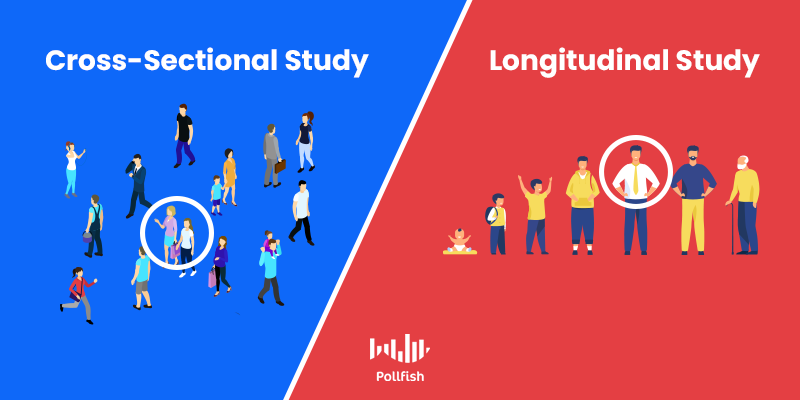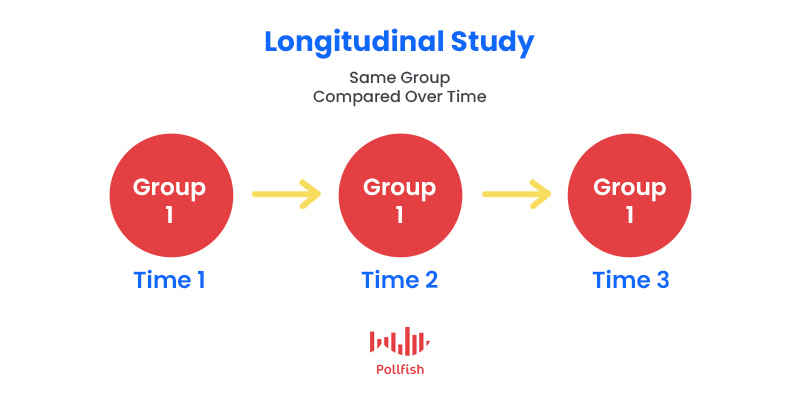Diving Into Longitudinal Surveys

Longitudinal surveys are the most powerful assets that marketers and market researchers can use when conducting longitudinal research.
We’ve previously highlighted the three main types of survey research methods, which include cross-sectional studies, longitudinal studies and retrospective studies. In this article, we will cover longitudinal surveys and their underlying studies.
You can apply longitudinal studies for a wide range of verticals and purposes. As such, it is crucial to learn about this research method so that you can set it off smoothly for your survey research needs.
Defining Longitudinal Surveys
A longitudinal study is defined as a study in which researchers gather data on the same set of variables (respondents) over a period of time. This kind of research grants researchers the ability to closely examine the trajectories and changes of their subjects over time.
This study includes gathering insights on the sample pool’s opinions, behaviors, sentiments, desires, reactions and several other aspects. Mostly used in medical and social sciences, this form of research is also invaluable for brands, as studying your target market is key to keeping your business alive.
A form of correlational research, researchers (and businesses) conduct longitudinal research via collecting data on a group of variables without influencing or affecting the variables in any way. Each data collection is called a wave.
It is optimal to conduct this kind of study via longitudinal surveys, as they are designed to garner all the questions you need and to create them in innovative ways.
The Key Aspects of Longitudinal Surveys
To fully understand longitudinal surveys, you should peruse some of their key features. This will help you understand their make up and decide whether to use them for your survey research.
The following lists the core facets that distinguish these surveys from that of others. Here is how they differ aside from their deployment frequency:
- These studies and their surveys gather insights over long-term periods.
- Despite being typically used for a long period of time, there is no fixed amount of time required to constitute a longitudinal study.
- These studies can range from several weeks to years and even decades.
- They are part of observational studies, in which no intervention takes place, only pure investigation.
- They involve repeated observations of the same group of participants.
- They are used to uncover relationships between variables that are not connected to background variables.
- They are used to discover how the sampling pool (respondents) changes over time.
- They are used after extracting some findings from cross-sectional studies, when those studies warrant more data and inquiry.
- They collect both quantitative and qualitative data.
- They can be conducted through primary research, along with secondary research.
- Primary sources: surveys, survey panels, interviews, focus groups
- Secondary sources: government websites, focused reports, ex: longitudinal studies on American youth
How They Differ from Cross-Sectional & Retrospective Surveys

Longitudinal studies are often contrasted with cross-sectional studies. They also differ from retrospective studies. The survey of each study follows suit, as it will be distinguished in design, function and deployment frequency.
Unlike longitudinal studies, cross-sectional studies involve examining samples of a given population (the cross-section) at a particular point in time. The surveys in this research method paint a snapshot of a sampling pool, usually the prevailing one.
As such, cross-sectional studies are far shorter to conduct. They are often used as precursors to longitudinal studies, in that they discover correlations that can be further probed longitudinally.
Retrospective studies combine aspects of both cross-sectional and longitudinal studies. They study respondents with surveys about past events. Researchers can thus compare past feelings and attitudes with those of the present, much like in longitudinal studies. In this way, these studies are used hand in hand with longitudinal studies, despite that retrospective studies form their own distinct set of research.
Retrospective surveys can be conducted just once, as are cross-sectional surveys. They may also amass data on several points in time. These surveys draw from a pool of an already existing data set.
As such, retrospective studies only deal with events of the past and will not gather any new data; that’s where longitudinal studies are needed to be used in tandem with them.
It’s important to note that all three of these research methods/survey types are observational, allowing researchers to record and understand the subjects’ behaviors via observation only.
The 3 Types of Longitudinal Surveys

Longitudinal studies can be carried out in various ways. There are three main classifications of longitudinal surveys: a panel study, a cohort study and a retrospective study. As mentioned above, retrospective studies make up their own major form of research. However, due to their close involvement with longitudinal studies, they can also exist as a form of these studies.
Panel study:
- It involves sampling a prerecruited set of survey respondents.
- These respondents agree to a particular length of participation.
- Surveys are sent to the exact same group of respondents.
Cohort study:
- It is conducted through online survey software.
- Respondent selection is set by way of shared characteristics, such as a geographical location, births and historical experiences.
- It also deals with respondents on the basis of demographics and opinions and behaviors (the latter two are collected via screening questions).
Retrospective study:
- It uses past information on the same or similar subjects (variables).
- It involves studying the past with recorded data. Ex: medical records, past surveys.
- It complements any current or soon-to-be gathered longitudinal data.
The first two types of surveys are part of prospective longitudinal research, in which a sampling pool is studied over a period of time. They therefore fall opposite to retrospective studies.
Which Industries Depend on these Surveys for Market Research
There are several industries that utilize longitudinal surveys for market research undertakings. These surveys, therefore, provide a wide variety of applications. The following list details the various verticals that rely on longitudinal surveys.
- Healthcare: Physicians, other healthcare providers and researchers can study any biological change in participants in terms of their lifestyle, i.e., their diets, their fitness/ sedentary habits, health upkeep, reactions to medicines and much more.
- Retail: Retailers can study shopping habits from time to time and discover how advancements in the sectors affect those habits or form new ones.
- Psychology: Psychologists can conduct these surveys to study how the mentality and psyche of various groups change over time in reaction to stimuli or any change.
- Education: Those in the education sector can use students’ test scores, work and products to track developments over time. Monitoring student progress can also identify disparities in academic performance levels among students.
- Real estate: Real estate agents and business owners can use these surveys to gather opinions of residents and businesses within a neighborhood or property over time.
- Technology: Tech leaders and manufacturers can learn how consumers change or develop certain behaviors due to the use of existing technology or the emergence of new kinds.
- General business: Brands can conduct these surveys to closely monitor their target market, especially in relation to their products. Additionally, businesses can study closely associated target markets or even different knees to gain new patrons.
Types of Business Surveys that Rely on Longitudinal Studies
Dovetailing onto the final industry using longitudinal data, that of general business, it is crucial to understand just the kinds of surveys that brands can use. This is because a wide array of survey types (based on the subdisciplines of business) can be applied in longitudinal studies. Here are a few key survey types:
- Marketing market research: Brands can use marketing surveys for market research to study trends in the market and within niches firsthand. They can also help businesses capture demand for their product/service, along with measuring campaign success.
- Customer Satisfaction: A major component of any business, there are a variety of surveys for this purpose, such as the Net Promoter Score (NPS), Customer Satisfaction Score (CSAT) and the Customer Effort Score (CES).
- Product feedback: These surveys provide necessary insight into the sentiment around product launches or existing products, should you want to test their levels of customer contentment. You can test for usability, awareness and general opinions on your products via longitudinal feedback.
- Employee engagement: Not all survey research is external, not even when it comes to the longitudinal variety. As such, it is apt for businesses to keep an eye on their employee engagement levels. This involves checking on employees’ comfort on the job and collaboration with others. A longitudinal survey on employee engagement will give you the full scope of your company’s pulse and how to improve it.
The Pros and Cons of Longitudinal Surveys
Longitudinal studies, like others, come with their own sets of benefits and stumbling blocks. You ought to consider both sides in order to get the full picture on this kind of research method. Understanding the pros and cons will help you determine whether it is worth using this kind of study and its accompanying survey(s). It will also keep you aware of what to expect.
Pros
- Longitudinal surveys allow you to monitor your target market and general sampling pool in real time. This allows you to place all insights sequentially and be able to correlate events with causes.
- This is the only study that gives you access into observing developments and life-spanning issues.
- These surveys allow you to study hypotheses conjectured at cross-sectional surveys to learn more and form educated decisions.
- This is the most optimal study for identifying causal relationships and cause and effect.
- It stamps out the risk of recall bias, which denotes the inability to remember past occurrences.
- It can be used within a variety of survey types and industries including ones not mentioned above such as advertising, community feedback and more.
- They allow you to discover which sentiments and behaviors are conditional and which withstand the test of time.
Cons
- These are the most time-consuming surveys; they may not work alongside other surveys since they’re results aren’t complete until the end of the studied period.
- They require the most resources and are the most expensive kind of survey to conduct.
- Respondents may drop off over time, as not all are going to be as committed to the study. This is known as selective attrition.
Beyond Market Research: Longitudinal Studies as Content Assets
Longitudinal studies take the most amount of dedication and commitment — both on the end of the researchers and respondents due to their time-consuming nature. Nonetheless, they are valuable sources of primary research.
For businesses, these kinds of surveys do far more than just provide firsthand insights and data. Marketing teams can delight in that conducting longitudinal studies provides an invaluable content marketing asset, the kind that will easily distinguish a brand from its competitors.
Many businesses rely on content to increase brand awareness and gain leads. In fact, 60% of marketers produce one piece of content per day to grow their business. There are brands that use it to boost their user experience (UX) and even retain their customers. While blogs and social posts are typical, a longitudinal study is a downloadable asset worth conducting. It may be enlightening enough to gain media attention.
Frequently asked questions
What are the three main types of survey research methods?
The three main types of survey research methods are longitudinal studies, cross-sectional studies, and retrospective studies.
Why are longitudinal surveys performed?
A longitudinal survey is one that is created in order to gather data from respondents over a period of time. Surveys are distributed multiple times to the same group of respondents in order to study how specific variables change over time.
Why are longitudinal surveys performed?
The purpose of a longitudinal survey is to understand how a group’s behaviors, opinions, feelings, needs, and desires change over a period of time.
How does a longitudinal study differ from a cross-sectional study?
Cross-sectional studies provide a snapshot of the sample pool at a specific point in time, while longitudinal studies provide many snapshots of the sample pool at specific points over a period of time.
What are the three types of longitudinal studies?
The three types of longitudinal studies are panel studies, cohort studies, and retrospective studies.
Pollfish Marketing Team
Ready to Try Pollfish?
Create your survey with AI, target high-quality respondents starting at $0.95 per complete, and start getting results in just minutes in real-time. From running a simple product concept survey to managing a constant stream of trackers for dozens of clients in dozens of countries, we’ve got you.
